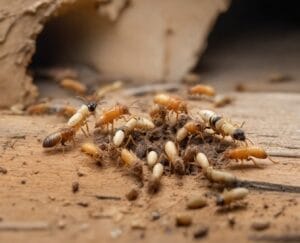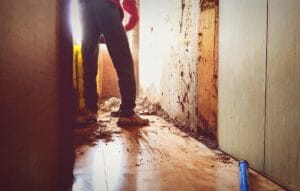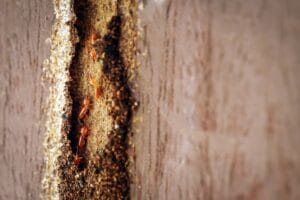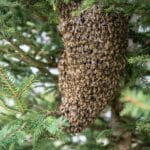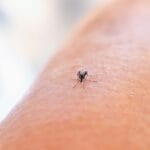When it comes to protecting your home, staying vigilant against termites is a top priority. These tiny critters might be out of sight, but the damage they can cause is certainly not out of mind. Let’s dive into how you can spot the early signs of a termite infestation, ensuring your home remains a safe haven, not a feast for unwelcome pests.
But first, let’s cut to the chase with some quick, actionable insights:
Key Takeaways
- Keep an eye out for mud tubes on exterior walls, as they’re highways for termites.
- Listen for a hollow sound when tapping on wood, which might indicate termite damage.
- Watch for discarded wings near windows or doors, signifying a recent termite swarm.
- Perform regular inspections in your home’s basement, attic, and foundation.
- Consider professional help if you spot signs of termites, as DIY methods might not be enough.
Recognizing the Stealthy Invaders: Termite Infestation Early Signs
Visual Clues of Termite Presence
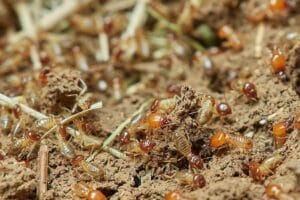
Termites are like the secret agents of the pest world, often causing damage before you even know they’re there. But, if you know what to look for, you can catch them red-handed. One of the most obvious signs is the presence of mud tubes. These are about the width of a pencil and usually run from the ground to wooden parts of your home. They’re termite highways, protecting these pests from predators as they munch away at your home’s structure.
Another giveaway is the sight of termite droppings, also known as frass. This looks like a dark, gritty powder near wooden items. It’s not something you want to find during spring cleaning, but spotting it early can save you a lot of trouble down the line.
Sounds That Betray Termite Activity
You might not see termites, but sometimes you can hear them. It’s subtle, but if you put your ear to a wall and hear a faint clicking sound, that’s termites talking to each other. They’re social insects, and they communicate by tapping their heads against wood. So, if your walls are ‘talking’, it’s time to listen up and take action.
Another acoustic hint is the hollow sound wood makes when it’s been eaten away by termites. Go ahead, give your wooden beams a gentle tap. If they sound more like a drum than solid wood, you may have some unwelcome diners.
Physical Structures Indicating Termite Habitation
Termites are architects in their own right, building complex structures to house their colonies. Besides mud tubes, they create nesting sites within wood or in the ground. If you stumble upon a termite nest, it’s a clear sign you’ve got a problem on your hands.
Most importantly, stay alert for these signs, especially if you live in an area known for termite activity. Prevention is always better than cure, and early detection is key to preventing a full-blown infestation.
DIY Methods to Confirm Termite Infestation
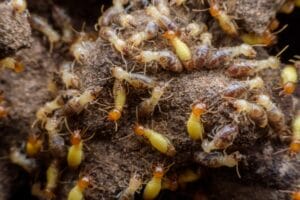
Before you call in the cavalry, there are a few do-it-yourself methods to confirm if you’re dealing with termites. Start by examining any wood around your home for signs of damage. Use a screwdriver to probe for hollow spots in exposed wood – it should be solid all the way through, so if it crumbles easily, you might have termites.
Another DIY method is to set up a simple termite bait station. Place a piece of damp cardboard near where you suspect termites might be. Termites are attracted to cellulose, which cardboard has plenty of. Check back after a few days; if you find termites or the cardboard is heavily damaged, it’s time to consider the next steps.
When to Call in the Professionals
DIY methods can be helpful, but they’re not foolproof. If you’ve found evidence of termites or if you’re not comfortable inspecting your home yourself, it’s time to call in professional pest control. They have the expertise and equipment to assess the situation accurately and recommend the best course of action. Besides that, termites can cause structural damage that’s not always visible, so getting a professional evaluation is a smart move.
Fortifying Your Home: Prevention Tips for Termite Infestation
Preventing termites is far less costly than treating them. Start by reducing moisture in and around your home, as termites thrive in damp environments. Fix leaks promptly, ensure proper drainage, and use dehumidifiers in basements and crawlspaces.
Regular Maintenance Checks
Regular home inspections can catch termite problems before they escalate. At least once a year, check your home’s foundation for signs of mud tubes, inspect wooden structures for damage, and look for changes in paint or wood appearance that might indicate a termite presence.
Essential Landscaping Practices
Your yard can either be your first line of defense or an open invitation to termites. Maintain a gap between any wood, such as mulch or firewood, and your home’s foundation. Trim back trees and shrubs that can provide a bridge for termites to enter your home.
Creating Barriers Against Termites
A physical barrier, like a termite shield, can deter termites from entering your home. These are typically installed during construction, but chemical barriers can be created around an existing home. These treatments involve applying termiticide to the soil around your home to prevent termites from reaching it.
Regularly inspect the barriers to ensure they remain intact and effective. Over time, soil can move, or landscaping changes can create breaches that termites will exploit.
Smart Construction Materials to Deter Termites
When building or renovating, choose materials that are less attractive to termites. Pressure-treated wood, for instance, is more resistant to termite damage. There are also composite materials that look like wood but contain no cellulose, which is what termites feed on.
Immediate Actions to Limit Damage
While waiting for professional help, you can take some immediate steps to limit further damage. Remove any sources of excess moisture, as this will make your home less appealing to termites. If possible, remove or isolate infested wood to prevent termites from spreading to other areas.
Remember, these steps are temporary measures until professional treatment can be administered. Termites are persistent, and home remedies are rarely a match for a full-blown infestation.
Understanding Your Pest Control Options
Once termites are confirmed, it’s crucial to understand your options for pest control. Most professional pest control services offer two main types of termite treatments: liquid termiticides and baiting systems. Liquid termiticides are applied to the soil around your home to create a chemical barrier that kills termites on contact or when they ingest it. Baiting systems, on the other hand, use a cellulose-based food attractive to termites and combine it with a slow-acting poison that they carry back to the colony.
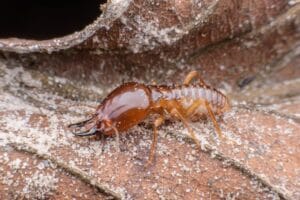
Each method has its advantages, and sometimes a combination of both is the best strategy. The key is to work with a trusted professional who can recommend a tailored solution based on the severity and location of the infestation.
Long-Term Strategies for Keeping Termites at Bay
After dealing with an infestation, the last thing you want is a repeat performance. Long-term strategies for termite prevention are essential. Besides the ongoing maintenance and landscaping tips mentioned earlier, consider an annual inspection by a pest control expert. They can catch signs of termite activity early and help maintain any barriers or treatments you have in place.
Another long-term strategy is to adjust your home’s environment to make it less attractive to termites. This can include reducing humidity in crawl spaces with proper ventilation, avoiding wood-to-soil contact, and storing firewood away from your house.
FAQs: Your Concerns Addressed
Now, let’s tackle some common questions you might have about termites and your home.
What Are the First Signs of a Termite Infestation?
The first signs of a termite infestation can include visible mud tubes on exterior walls, hollow-sounding wood, and discarded wings from termite swarmers. Keep an eye out for these indicators, as early detection can save you significant time and money.
Can I Use DIY Techniques to Get Rid of Termites?
While DIY techniques can help confirm an infestation, they are not usually effective at eradicating termites. Professional pest control services are recommended because they have the expertise and tools necessary to fully address the problem.
How Frequently Should I Inspect My Home for Termites?
You should inspect your home for termites at least once a year. If you live in an area with a high termite risk, consider inspections more frequently, or set up an annual contract with a pest control service.
What Should I Do if I Find Termites in My House?
If you find termites in your house, contact a professional pest control service as soon as possible. They can assess the extent of the infestation and recommend the best treatment method.
Are There Any Natural Predators That Help Control Termite Populations?
Yes, there are natural predators like ants, beetles, and birds that feed on termites. However, relying solely on these predators isn’t a practical termite control strategy. Integrated pest management that includes professional services is more effective.
Remember, your home is one of your most significant investments, and protecting it from termites should be a top priority. Stay vigilant, take preventive measures, and don’t hesitate to call in the experts. With the right approach, you can keep your home termite-free and maintain its structural integrity for years to come.
